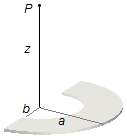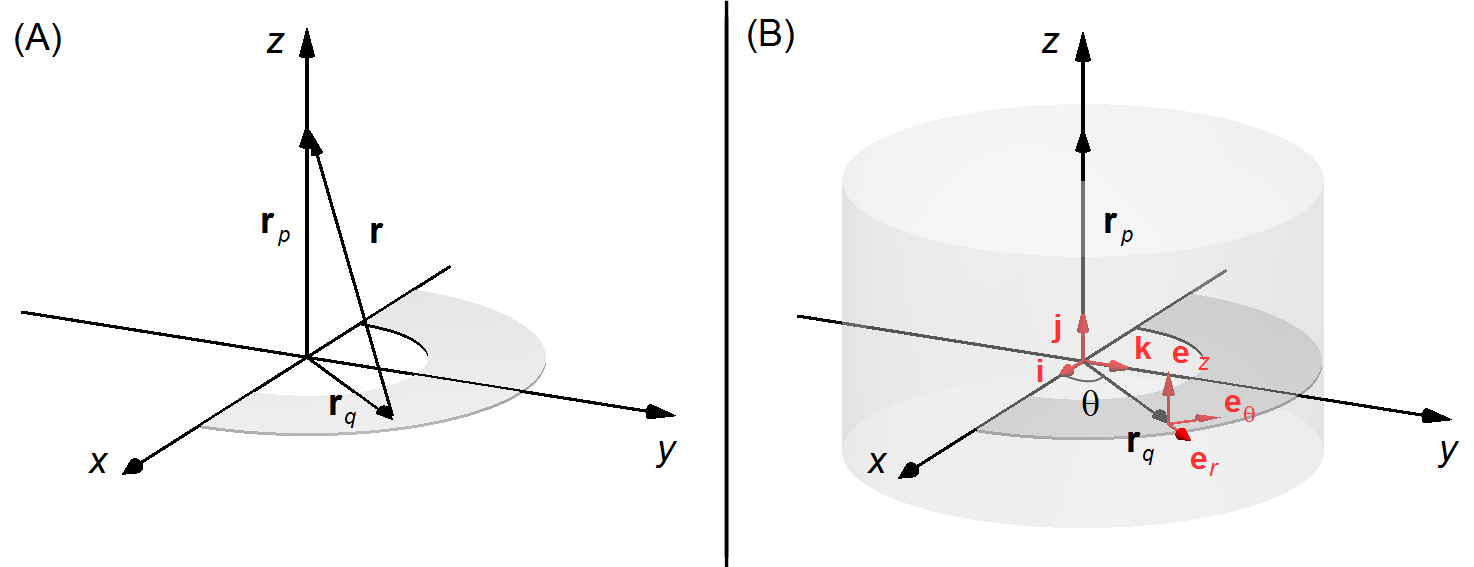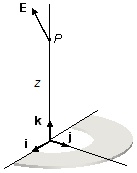Exercício Resolvido de Força Elétrica e Campo Elétrico
publicidade
Uma chapa semicircular possui raio externo a e raio interno b. A chapa está carregada com
uma carga total Q distribuída de forma não uniforme diretamente proporcional ao ângulo central
θ do semicírculo de tal forma que
\( 0 \leq \theta \leq \pi \).
Calcule o vetor campo elétrico num ponto P sobre o eixo perpendicular ao plano do semicírculo que
passa pelo centro de curvatura a uma distância z do seu centro.

Dados do problema:
- Raio externo do semicírculo: a;
- Raio interno do semicírculo: b;
- Carga da chapa: Q;
- Distância ao ponto onde se quer o campo elétrico: z.
A densidade superficial de carga do semicírculo é diretamente proporcional à posição angular da carga
(Figura 1)
\[
\begin{gather}
\sigma (\theta )=\alpha \;\theta \tag{I}
\end{gather}
\]
onde α é uma constante que torna a expressão dimensionalmente consistente.

Figura 1
O vetor posição r vai de um elemento de carga dq do disco até o ponto P onde se deseja calcular o campo elétrico, o vetor rq localiza o elemento de carga em relação à origem do referencial e o vetor rp localiza o ponto P (Figura 2-A).
\[
\mathbf{r}={\mathbf{r}}_{p}-{\mathbf{r}}_{q}
\]

Pela geometria do problema devemos escolher coordenadas cilíndricas (Figura 2-B), o vetor rq, só possui componente na direção er, \( {\mathbf{r}}_{q}=r_{q}\;\mathbf{e}_{r} \), e o vetor rp só possui componente na direção ez, \( {\mathbf{r}}_{p}=r_{p}\;\mathbf{e}_{z} \). Fazendo a conversão de coordenadas cilíndricas para coordenadas cartesianas x, y e z são dados por
\[
\left\{
\begin{array}{l}
x=r_{q}\cos \theta \\
y=r_{q}\operatorname{sen}\theta \\
z=z
\end{array}
\right. \tag{II}
\]
Observação: Na Figura 2-B, i, j e k são os vetores unitários da base do
sistema de coordenadas cartesianas, e er, eθ e
ez são os vetores unitários da base do sistema de coordenadas cilíndricas.
Depois da conversão o vetor rq, é escrito como \( {\mathbf{r}}_{q}=x\;\mathbf{i}+y\;\mathbf{j} \), e o vetor rp como \( {\mathbf{r}}_{p}=z\;\mathbf{k} \).
O vetor posição será
\[
\begin{gather}
\mathbf{r}=z\;\mathbf{k}-\left(x\;\mathbf{i}+y\;\mathbf{j}\right)\\
\mathbf{r}=-x\;\mathbf{i}-y\;\mathbf{j}+z\;\mathbf{k} \tag{III}
\end{gather}
\]
Da expressão (III) o módulo do vetor posição r será
\[
\begin{gather}
r^{2}=(-x)^{2}+(-y)^{2}+z^{2}\\
r=\left(x^{2}+y^{2}+z^{2}\right)^{\frac{1}{2}} \tag{IV}
\end{gather}
\]
Solução
O vetor campo elétrico é dado por
\[ \bbox[#99CCFF,10px]
{\mathbf{E}=\frac{1}{4\pi \epsilon_{0}}\int{\frac{dq}{r^{2}}\;\frac{\mathbf{r}}{r}}}
\]
\[
\begin{gather}
\mathbf{E}=\frac{1}{4\pi \epsilon_{0}}\int{\frac{dq}{r^{3}}\;\mathbf{r}} \tag{V}
\end{gather}
\]
Da expressão da densidade superficial de carga σ obtemos o elemento de carga dq
\[ \bbox[#99CCFF,10px]
{\sigma =\frac{dq}{dA}}
\]
\[
\begin{gather}
dq=\sigma(\theta) \;dA \tag{VI}
\end{gather}
\]

Figura 3
onde dA é um elemento de área de ângulo dθ do disco (Figura 3)
\[
\begin{gather}
dA=r_{q}\;dr_{q}\;d\theta \tag{VII}
\end{gather}
\]
substituindo as expressões (I) e (VII) na expressão (VI)
\[
\begin{gather}
dq=\alpha \theta r_{q}\;dr_{q}\;d\theta \tag{VIII}
\end{gather}
\]
Substituindo as expressões (III), (IV) e (VIII) na expressão (V), e como a integração é feita sobre a
superfície do semicírculo, depende de duas variáveis rq e θ, temos uma integral dupla
\[
\begin{gather}
\mathbf{E}=\frac{1}{4\pi \epsilon_{0}}\iint{\frac{\alpha \theta r_{q}\;dr_{q}\;d\theta}{\left[\left(x^{2}+y^{2}+z^{2}\right)^{\frac{1}{2}}\right]^{3}}}\left(-x\;\mathbf{i}-y\;\mathbf{j}+z\;\mathbf{k}\right)\\
\mathbf{E}=\frac{1}{4\pi\epsilon_{0}}\iint{\frac{\alpha \theta r_{q}\;dr_{q}\;d\theta}{\left(x^{2}+y^{2}+z^{2}\right)^{\frac{3}{2}}}}\left(-x\;\mathbf{i}-y\;\mathbf{j}+z\;\mathbf{k}\right) \tag{IX}
\end{gather}
\]
substituindo as expressões (II) na expressão (IX)
\[
\begin{gather}
\mathbf{E}=\frac{1}{4\pi \epsilon_{0}}\iint{\frac{\alpha \theta r_{q}\;dr_{q}\;d\theta}{\left[\left(r_{q}\cos \theta\right)^{2}+\left(r_{q}\operatorname{sen}\theta\right)^{2}+z^{2}\right]^{\frac{3}{2}}}\left(-r_{q}\cos \theta\;\mathbf{i}-r_{q}\operatorname{sen}\theta\;\mathbf{j}+z\;\mathbf{k}\right)}\\[5pt]
\mathbf{E}=\frac{1}{4\pi \epsilon_{0}}\iint{\frac{\alpha \theta r_{q}\;dr_{q}\;d\theta}{\left[r_{q}^{2}\cos ^{2}\theta +r_{q}^{2}\operatorname{sen}^{2}\theta+z^{2}\right]^{\frac{3}{2}}}\left(-r_{q}\cos \theta\;\mathbf{i}-r_{q}\operatorname{sen}\theta\;\mathbf{j}+z\;\mathbf{k}\right)}\\[5pt]
\mathbf{E}=\frac{1}{4\pi \epsilon_{0}}\iint{\frac{\alpha \theta r_{q}\;dr_{q}\;d\theta}{\left[r_{q}^{2}\underbrace{\left(\cos ^{2}\theta+\operatorname{sen}^{2}\theta\right)}_{1}+z^{2}\right]^{\frac{3}{2}}}\left(-r_{q}\cos \theta\;\mathbf{i}-r_{q}\operatorname{sen}\theta\;\mathbf{j}+z\;\mathbf{k}\right)}\\[5pt]
\mathbf{E}=\frac{1}{4\pi \epsilon_{0}}\iint{\frac{\alpha \theta r_{q}\;dr_{q}\;d\theta}{\left(r_{q}^{2}+z^{2}\right)^{\frac{3}{2}}}\left(-r_{q}\cos \theta\;\mathbf{i}-r_{q}\operatorname{sen}\theta\;\mathbf{j}+z\;\mathbf{k}\right)}
\end{gather}
\]
Como α é constante ele pode “sair” da integral, e a integral da soma é igual à soma das integrais
\[
\mathbf{E}=\frac{\alpha}{4\pi \epsilon_{0}}\left(-\iint{\frac{r_{q}^{2}\theta \cos \theta \;dr_{q}\;d\theta}{\left(r_{q}^{2}+z^{2}\right)^{\frac{3}{2}}}}\;\mathbf{i}-\iint{\frac{r_{q}^{2}\theta \operatorname{sen}\theta \;dr_{q}\;d\theta}{\left(r_{q}^{2}+z^{2}\right)^{\frac{3}{2}}}}\;\mathbf{j}+z\iint{\frac{r_{q}\theta \;dr_{q}\;d\theta}{\left(r_{q}^{2}+z^{2}\right)^{\frac{3}{2}}}}\;\mathbf{k}\right)
\]
Os limites de integração serão de b até a em drq, ao longo do raio do
semicírculo, e de 0 e π em dθ, meia volta, e como não existem termos “cruzados“ em
rq e θ as integrais podem ser separadas
\[
\begin{split}
\mathbf{E}=&\frac{\alpha}{4\pi\epsilon_{0}}\left(-\int_{b}^{a}{\frac{r_{q}^{2}\;dr_{q}}{\left(r_{q}^{2}+z^{2}\right)^{\frac{3}{2}}}}\int_{0}^{\pi}\theta \cos \theta \;d\theta\;\mathbf{i}-\int_{b}^{a}{\frac{r_{q}^{2}\;dr_{q}}{\left(r_{q}^{2}+z^{2}\right)^{\frac{3}{2}}}}\int_{0}^{\pi}\theta \operatorname{sen}\theta \;d\theta\;\mathbf{j}+\right.\\
&\left. +z\int_{b}^{a}{\frac{r_{q}\;dr_{q}}{\left(r_{q}^{2}+z^{2}\right)^{\frac{3}{2}}}}\int_{0}^{\pi}\theta \;d\theta \;\mathbf{k}\right)
\end{split}
\]
colocando a integral
\( \int_{b}^{a}{\frac{r_{q}^{2}\;dr_{q}}{\left(r_{q}^{2}+z^{2}\right)^{\frac{3}{2}}}} \)
em evidência
\[
\mathbf{E}=\frac{\alpha}{4\pi \epsilon_{0}}\int_{b}^{a}{\frac{r_{q}^{2}\;dr_{q}}{\left(r_{q}^{2}+z^{2}\right)^{\frac{3}{2}}}}\left(-\int_{0}^{\pi}\theta \cos \theta \;d\theta\;\mathbf{i}-\int _{0}^{\pi}\theta\operatorname{sen}\theta \;d\theta \;\mathbf{j}+z\int_{0}^{\pi}\theta \;d\theta \;\mathbf{k}\right)
\]
Integração de \( \displaystyle \int_{b}^{a}{\frac{r_{q}\;dr_{q}}{\left(r_{q}^{2}+z^{2}\right)^{\frac{3}{2}}}} \)
fazendo a mudança de variável
para rq = b
temos \( u=b^{2}+z^{2} \)
para rq = a
temos \( u=a^{2}+z^{2} \)
fazendo a mudança de variável
\[
\begin{array}{l}
u=r_{q}^{2}+z^{2}\\
\dfrac{du}{dr_{q}}=2r_{q}\Rightarrow dr_{q}=\dfrac{du}{2r_{q}}
\end{array}
\]
fazendo a mudança dos extremos de integração
para rq = b
temos \( u=b^{2}+z^{2} \)
para rq = a
temos \( u=a^{2}+z^{2} \)
\[
\begin{align}
\int_{{b^{2}+z^{2}}}^{{a^{2}+z^{2}}}{\frac{r_{q}}{u^{\frac{3}{2}}}\;\frac{du}{2r_{q}}} &\Rightarrow\frac{1}{2}\int_{{b^{2}+z^{2}}}^{{a^{2}+z^{2}}}{\frac{1}{u^{\frac{3}{2}}}\;du}\Rightarrow\;\frac{1}{2}\left.\frac{u^{-{\frac{3}{2}+1}}}{-{\left(\frac{3}{2}+1\right)}}\;\right|_{\;b^{2}+z^{2}}^{\;a^{2}+z^{2}}\Rightarrow \\[5pt]
&\Rightarrow\frac{1}{2}\left.\frac{u^{\frac{-3+2}{2}}}{\left(\frac{-{3+2}}{2}\right)}\;\right|_{\;b^{2}+z^{2}}^{\;a^{2}+z^{2}}\Rightarrow \cancel{\frac{1}{2}}\left.\frac{u^{-{\frac{1}{2}}}}{-{\cancel{\frac{1}{2}}}}\;\right|_{\;b^{2}+z^{2}}^{\;a^{2}+z^{2}}\Rightarrow \\[5pt]
&\Rightarrow\left.-u^{-{\frac{1}{2}}}\;\right|_{\;b^{2}+z^{2}}^{\;a^{2}+z^{2}}\Rightarrow\left.-{\frac{1}{u^{\frac{1}{2}}}}\;\right|_{\;b^{2}+z^{2}}^{\;a^{2}+z^{2}}\Rightarrow \\[5pt]
&\Rightarrow-\left(\frac{1}{\sqrt{a^{2}+z^{2}}}-\frac{1}{\sqrt{\;b^{2}+z^{2}}}\right)\Rightarrow\\[5pt]
&\Rightarrow\frac{1}{\sqrt{b^{2}+z^{2}\;}}-\frac{1}{\sqrt{\;a^{2}+z^{2}\;}}
\end{align}
\]
Integração de \( \displaystyle \int_{0}^{\pi}\theta \cos \theta \;d\theta \)
Usando Integração por Partes \( \int uv'=uv-\int u'v \), escolhemos
Usando Integração por Partes \( \int uv'=uv-\int u'v \), escolhemos
\[
\begin{array}{l}
u=\theta \qquad \qquad \; v'=\cos \theta \\
u'=1\qquad \qquad v=\operatorname{sen}\theta
\end{array}
\]
\[
\begin{align}
\int_{0}^{\pi}\theta \cos \theta \;d\theta &\Rightarrow\theta\operatorname{sen}\theta |_{\;0}^{\;\pi}-\int_{0}^{\pi}\operatorname{sen}\theta \;d\theta\Rightarrow\\[5pt]
&\Rightarrow\theta \operatorname{sen}\theta \;|_{\;0}^{\;\pi}-\left(-\cos \theta \;|_{\;0}^{\;\pi}\right)\Rightarrow\\[5pt]
&\Rightarrow\theta \operatorname{sen}\theta \;|_{\;0}^{\;\pi}+\cos \theta \;|_{\;0}^{\;\pi}\Rightarrow\\[5pt]
&\Rightarrow\left(\pi.\operatorname{sen}\pi-0.\operatorname{sen}0\;\right)+\left(\cos \pi -\cos 0\right)\Rightarrow\\[5pt]
&\Rightarrow\left(\pi.0-0.0\right)+\left(-1-1\right)\Rightarrow-2
\end{align}
\]
Integração de \( \displaystyle \int_{0}^{\pi}\theta \operatorname{sen}\theta \;d\theta \)
Usando Integração por Partes \( \int uv'=uv-\int u'v \), escolhemos
Usando Integração por Partes \( \int uv'=uv-\int u'v \), escolhemos
\[
\begin{array}{l}
u=\theta\qquad \qquad \; v'=\operatorname{sen}\theta \\
u'=1\qquad \qquad v=-\cos \theta
\end{array}
\]
\[
\begin{align}
\int_{0}^{\pi}\theta \operatorname{sen}\theta\;d\theta &\Rightarrow-\theta \cos \theta \;|_{\;0}^{\;\pi}-\int_{0}^{\pi}-\cos\theta \;d\theta\Rightarrow\\[5pt]
&\Rightarrow-\theta \cos \theta \;|_{\;0}^{\;\pi}+\int_{0}^{\pi}\cos\theta \;d\theta\Rightarrow\\[5pt]
&\Rightarrow-\theta \cos \theta \;|_{\;0}^{\;\pi}+\operatorname{sen}\theta \;|_{0}^{\pi}\Rightarrow\\[5pt]
&\Rightarrow-\left(\pi .\cos \pi -0.\cos0\right)+\left(\operatorname{sen}\pi -\operatorname{sen}0\right)\Rightarrow\\[5pt]
&\Rightarrow-\left[\pi.(-1)-0.1\right]+\left(0-0\right)\Rightarrow\\[5pt]
&\Rightarrow\int_{0}^{\pi}\theta \operatorname{sen}\theta\;d\theta \Rightarrow\pi
\end{align}
\]
Integração de \( \displaystyle \int_{0}^{\pi}\;d\theta \)
\[
\int_{0}^{\pi}\;d\theta =\left.\theta \;\right|_{\;0}^{\;\pi}=\pi-0=\pi
\]
\[
\mathbf{E}=\frac{\alpha}{4\pi \epsilon_{0}}\left(\frac{1}{\sqrt{b^{2}+z^{2}}}-\frac{1}{\sqrt{a^{2}+z^{2}\;}}\right)\left[-(-2)\;\mathbf{i}-\pi\;\mathbf{j}+z\pi \;\mathbf{k}\right]
\]
\[ \bbox[#FFCCCC,10px]
{\mathbf{E}=\frac{\alpha}{4\pi \epsilon_{0}}\left(\frac{1}{\sqrt{b^{2}+z^{2}\;}}-\frac{1}{\sqrt{a^{2}+z^{2}\;}}\right)\left(2\;\mathbf{i}-\pi\;\mathbf{j}+z\pi \;\mathbf{k}\right)}
\]

Figura 4
publicidade

Fisicaexe - Exercícios Resolvidos de Física de Elcio Brandani Mondadori está licenciado com uma Licença Creative Commons - Atribuição-NãoComercial-Compartilha Igual 4.0 Internacional .